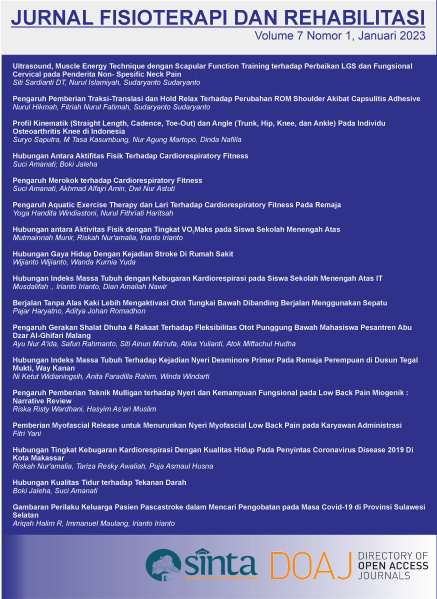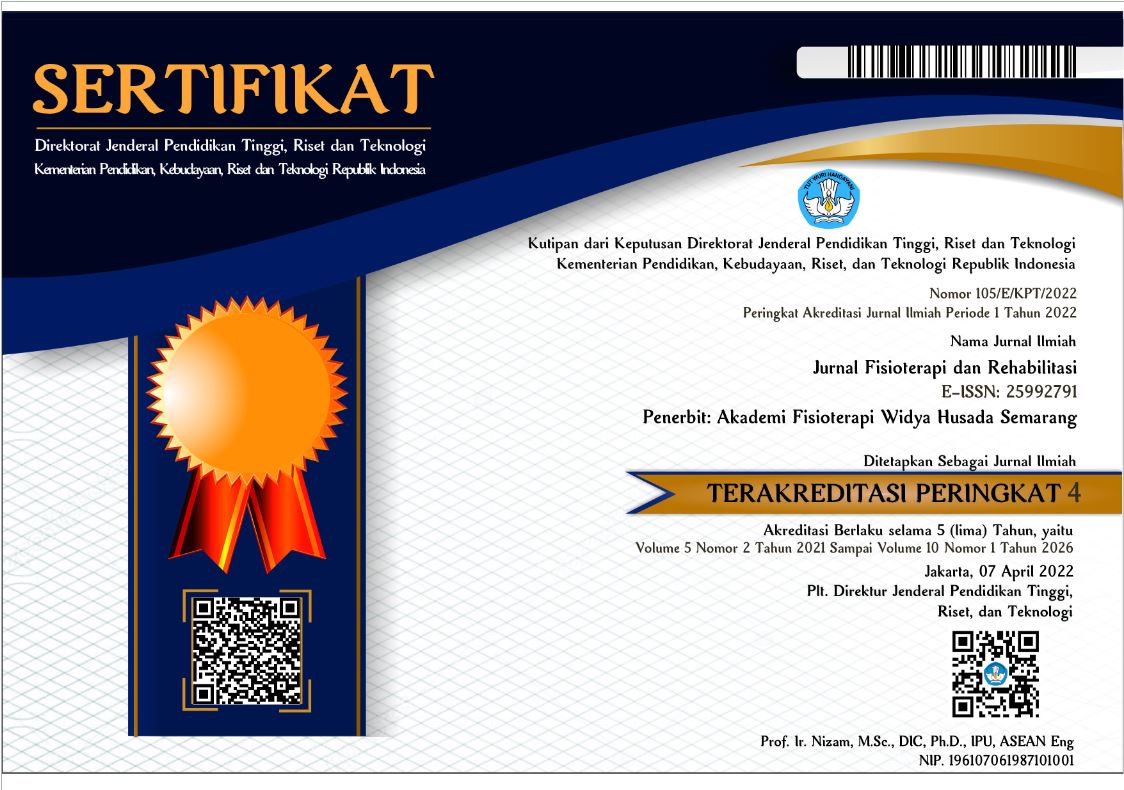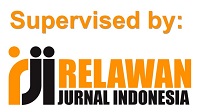Pengaruh Pemberian Teknik Mulligan terhadap Nyeri dan Kemampuan Fungsional pada Low Back Pain Miogenik : Narrative Review
Effect of Mulligan Technique on Pain and Functional Ability in Myogenic Low Back Pain: Narrative Review
Abstract
Low Back pain merupakan gangguan musculoskeletal dengan tanda rasa nyeri di area sekitar punggung bawah, Insidensi banyak terjadi pada low back pain miogenik, ini meningkat sesuai dengan bertambahnya usia. intervensi fisioterapi yang digunakan untuk mengurangi nyeri dengan teknik mulligan SNAGS. Untuk mengetahui pengaruh teknik mulligan SNAGS terhadap penurunan nyeri dan kemampuan fungsional pada pasien low back pain. Narrative Review dengan metode PICO, yaitu P (Patient, Problem, Population), I (Intervention), C (Comparison), dan O (Outcome) serta memenuhi kriteria inklusi dan eksklusi. Pencarian artikel dilakukan di beberapa database yaitu Pubmed, DOAJ, dan Science Direct. Berdasarkan hasil review dari 10 artikel, terdapat 8 artikel yang menyatakan bahwa teknik mulligan terbukti efektif dalam menurunkan nyeri pada Low Back Pain, sedangkan 2 artikel lainnya menyatakan bahwa teknik terapi manual serta stabilisasi tulang belakang terbukti lebih unggul daripada teknik mulligan. Teknik mulligan terbukti efektif untuk mengurangi nyeri dan meningkatkan kemampuan fungsional,serta menjadi terapi latihan kombinasi pengobatan pada kasus Low Back Pain myogenic dengan dosis 3 set 6 kali pengulangan dan setiap set nya 10 repitisi selama 3 minggu.
Downloads
References
Dinas kesehatan Kabupaten Bantul. (2019). Narasi Profil Kesehatan Kabupaten Bantul Tahun 2019. Dinkes Bantul, 13(1), 15–20.
Fiaad, M. N., Elsayed, W. H., Kamal, M., Takla, N., Zawahry, A. M. El, Dasar, I., Fisik, F. T., & Modern, U. (2020). Mobilisasi Mulligan vs . efek manipulasi tulang belakang pada nyeri punggung bawah Intervensi Program latihan standar Semua peserta melakukan program latihan penguatan dan. 70–75.
Hidalgo, B., Pitance, L., Hall, T., Detrembleur, C., & Nielens, H. (2015). Short-Term Effects of Mulligan Mobilization with Movement on Pain, Disability, and Kinematic Spinal Movements in Patients with Nonspecific Low Back Pain: A Randomized Placebo-Controlled Trial. Journal of Manipulative and Physiological Therapeutics, 38(6), 365–374. https://doi.org/10.1016/j.jmpt. 2015.06.013
Hussien, H. M., Abdel-Raoof, N. A., Kattabei, O. M., & Ahmed, H. H. (2017). Effect of Mulligan Concept Lumbar SNAG on Chronic Nonspecific Low Back Pain. Journal of Chiropractic Medicine, 16(2), 94–102. https://doi.org/10.1016/j.jcm.2017.01.003
Khan, S., Al Torairi, N., & Shamsi, S. (2018). Comparative Study Of Snags And Maitland’s Mobilization In Chronic Low Back Pain Efficacy of K-Tape in Chronic Mechanical Low Back Pain View project Comparative Study Of Snags And Maitland’s Mobilization In Chronic Low Back Pain View project European Journ. Journal of Physical Education and Sport Science, 4, 71–84. https://doi.org/10.5281/zenodo.1471519
Kotteswaran., Jothilingam, M., Alagesan, J., & Manikumar, M. (2019). Comparison of Mulligan Technique and Conventional Technique in Patients with Low Back Pain. Journal of Emerging Technologies and Innovative Research, March 2020. SIA : Jurnal Etnografi Indonesia, 1(2), 27. https://doi.org/10.31947/etnosia.v1i2.1613
Mohan Kumar, G., Paul, J., Sundaram, M. S., & Mahendranath, P. (2020). Comparative Effect of Mulligans Mobilisation Versus Stabilisation Exercise on Chronic Nonspecific Low Back Pain: A Pilot Study. Indian Journal of Public Health Research & Development, 11(1), 1283. https://doi.org/10.37506/v11/i1/2020 /ijphrd/194019

This work is licensed under a Creative Commons Attribution 4.0 International License.
The use of the article will be governed by the Creative Commons Attribution license as currently displayed on Creative Commons Attribution 4.0 International License.
Author’s Warranties
The author warrants that the article is original, written by stated author(s), has not been published before, contains no unlawful statements, does not infringe the rights of others, is subject to copyright that is vested exclusively in the author and free of any third party rights, and that any necessary written permissions to quote from other sources have been obtained by the author(s).
User Rights
JFR's spirit is to disseminate articles published are as free as possible. Under the Creative Commons license, JFR permits users to copy, distribute, display, and perform the work. Users will also need to attribute authors and JFR on distributing works in the journal.
Rights of Authors
Authors retain all their rights to the published works, such as (but not limited to) the following rights;
- Copyright and other proprietary rights relating to the article, such as patent rights,
- The right to use the substance of the article in own future works, including lectures and books,
- The right to reproduce the article for own purposes,
- The right to self-archive the article
Co-Authorship
If the article was jointly prepared by other authors, any authors submitting the manuscript warrants that he/she has been authorized by all co-authors to be agreed on this copyright and license notice (agreement) on their behalf, and agrees to inform his/her co-authors of the terms of this policy. JFR will not be held liable for anything that may arise due to the author(s) internal dispute. JFR will only communicate with the corresponding author.
Miscellaneous
JFR will publish the article (or have it published) in the journal if the article’s editorial process is successfully completed. JFR's editors may modify the article to a style of punctuation, spelling, capitalization, referencing and usage that deems appropriate. The author acknowledges that the article may be published so that it will be publicly accessible and such access will be free of charge for the readers as mentioned in point 3.












